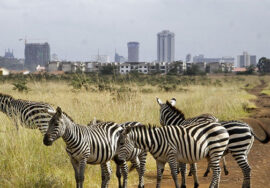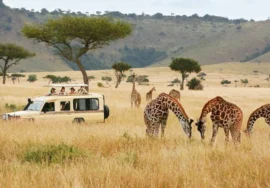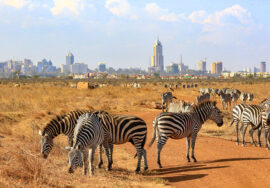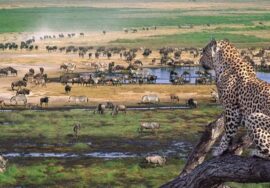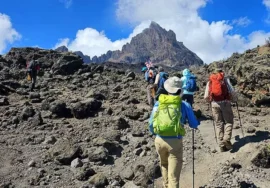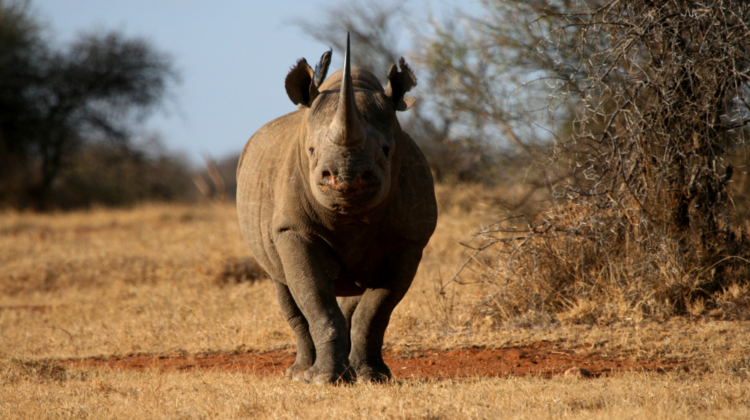
Your Complete Guide to Rhinos
Your Complete Guide to Rhinos, The rhino is one of nature’s gentle giants.
Get ready for an interesting trip into the world of rhinos, one of the most famous and threatened animals in Africa. These beautiful animals, which look like they came from prehistoric times and are incredibly strong, are an important part of Kenya’s amazing wildlife history. People who go on safari are amazed by these animals’ size, strength, and grace, from the huge white rhino to the hard to find and critically threatened black rhino.
This book will teach you interesting facts about rhinos, where they live and what they do, as well as the important protection efforts that keep them safe. We’ll also answer some of the most common questions people have about rhinos, which will help you understand their place in Africa’s environment better. This guide will make you appreciate one of nature’s most amazing products, whether you’re planning a safari or just want to learn more about these gentle giants.
Ten interesting facts about rhinos
The skin on rhinos is thick and sensitive.
It’s hard to believe that a rhino’s skin is so sensitive to heat and bug bites. That’s why they love to roll around in mud—it protects them from the sun and keeps bugs away.
They come in five different species.
There are five types of rhinos in the world. The white and black rhinos live in Africa, and the Indian, Javan, and Sumatran rhinos live in Asia. One thing that makes each species special is its horn. For example, the Indian rhino has one, and the white rhino has two.
Keratin is what rhino horns are made of.
Rhino horns are made of keratin, which is the same stuff that hair and nails are made of. This interesting system keeps growing for their whole lives.
Rhinos Move Quite Quickly
Rhinos can run as fast as 50 km/h (31 mph), even though they are big. They can avoid being eaten in the wild because they are fast and agile.
Rhinos that look white aren’t really white.
Their wide mouths are what gave them the name “white rhino.” The name comes from a wrong version of the Afrikaans word “wijd,” which means “wide.” In fact, they are dark, just like black rhinos.
White rhinos eat grass, while black rhinos browse.
Black rhinos eat bushes and trees, and they can grab twigs with their sharp lips. White rhinos, on the other hand, have flat, wide mouths that are great for eating grass.
Rhinos’ young are called calves.
Rhino babies are born after being inside their mothers for about 16 months. Before going out on their own, they stay with their moms for up to three years and learn how to stay alive.
Rhinos talk to each other through their poop and urine.
As a way to mark their area, rhinos leave dung piles, which are also called middens, and urine. These smells tell you about their age, sex, and even whether they are fertile.
Rhinos can’t see well but have great senses.
Rhinos can’t see very well, so they use their strong senses of smell and sound to find their way around. They can smell people or other animals from a long way away.
Rhinos are very important to ecosystems.
As mega-herbivores, rhinos change the environment by grazing and browsing, which helps a wide range of plants survive. Their waste also helps keep nutrients moving and gives bugs and smaller animals food.
Help Protect Rhinos
Keeping rhinos safe through conservation efforts
Rhino protection is an international effort, but East Africa is very important in keeping these animals alive. Poaching and ecosystem loss are very bad for black and white rhinos, which are native to the area. To deal with these problems, conservation programs in Kenya and nearby countries have put in place steps to stop poaching, work with the community, and restore habitats. National parks and conservancies protect rhinos by giving them safe places to live and the things they need to stay alive. They also provide controlled settings for populations to grow.
How National Parks Can Help Protect Rhinos
The best places to protect rhinos are Kenya’s national parks, like Lake Nakuru and Nairobi National Park. To stop poaching, these parks have safe, fenced areas that are watched over by rangers and backed by cutting-edge technology like GPS tracking. These parks make sure rhinos have food, water, and room to thrive by protecting their homes. People who visit these parks not only get to see rhinos in the wild, but they also directly help with conservation efforts by paying park fees that pay for ongoing protection programs.
Rhinos Get Help from the Community and Tourists
Getting local people involved in conservation activities has helped organizations like Ol Pejeta do more. By giving people jobs, schooling, and ways to share in the money made from rhino protection projects, communities become active participants in protecting rhinos. Responsible tourism is also very important because trips to these parks and conservancies help pay for important projects like animal care, breeding programs, and keeping the habitats in good shape.
National parks, wildlife refuges, and movements around the world are all working together to give rhinos a fighting chance at a safe future. Seeing these attempts for yourself on safari gives you hope and makes you realize how important it is to protect wildlife for future generations.
Rhino FAQs: All the answers you need to know about rhinos!
Rhino FAQs: Facts About Conservation
Why do rhinos need to be saved?
Wildlife crime and environmental loss have made rhinos vulnerable to extinction. Poachers kill rhinos for their horns, which are very valuable in the illegal wildlife trade. At the same time, farming and building cities destroy rhinos’ natural environments. Rhino populations are being protected through conservation measures, but they are still in grave danger.
There must be a lot of white rhino left.
As of 2023, there are still about 17,464 white rhinos living in the wild. This is a big increase from the early 1900s, when there were less than 100 of them, which was a very bad situation. Most of these rhinos live in South Africa. There are also smaller groups in Namibia, Zimbabwe, Kenya, and Eswatini. Conservation efforts have been very important in helping them get better, but hunting is still a big problem that could kill them.
How many rhinos are still alive?
Around 27,000 rhinos are still alive in the world. There are five kinds of rhinos: the white rhino, the black rhino, the Indian rhino, the Javan rhino, and the Sumatran rhino. There are smaller groups of rhinos in Namibia, Kenya, India, and Indonesia, but most of them live in South Africa. Some groups have become more stable thanks to conservation efforts, but rhinos are still in danger from poaching and habitat loss.
Are there no more rhinos?
There are still five kinds of rhinoceroses left in the world, so they are not extinct. The populations of white and black rhinos are slowly getting better thanks to ongoing conservation efforts. However, the Javan and Sumatran rhinos are seriously endangered. Their life is still in danger because of poaching and habitat loss, so conservation efforts are very important for their future.
Are there no more white rhinos?
White rhinos are not dead, but they are very close to going extinct. About 17,000 white rhinos are still alive, and most of them live in South Africa. There are also smaller groups of rhinos in other African countries. Even though attempts to protect them have helped their numbers grow again, poaching and habitat loss are still major threats to their survival.
How many white rhinos are still alive in the north?
There are only two female northern white rhinos left in the world as of 2023. The Ol Pejeta Conservancy in Kenya is a very safe place for these last few northern white rhinos to live. Poaching and habitat loss made the subspecies “functionally extinct” in the wild, as there were no known healthy males left to reproduce.
There must be a lot of black rhinos left.
About 5,000 black rhinos are still alive in the world as of 2023. These rhinos can mostly be found in South Africa, Kenya, and Zimbabwe. Conservation efforts are working to keep their populations stable. Even with these improvements, poaching and habitat loss still make black rhinos extremely endangered.
Why do black rhinos need to be saved?
Poaching for their horns and habitat loss are the main reasons why black rhinos are in danger of going extinct. Their horns are very valuable in the illegal wildlife trade, and people are also destroying their natural environments, which puts them in danger. To stop poaching and keep these rhinos safe in the wild, conservation measures are very important.
Which rhino is no longer alive?
The International Union for Conservation of Nature (IUCN) said that the Western Black Rhino was no longer alive in 2011. This type of black rhino lived mostly in central and western Africa, but it went extinct because of hunting and habitat loss. Conservation attempts are still going on to keep other rhino species from going through the same thing.
Then why do people steal rhino horns?
Rhino horns are mostly stolen because they are very valuable on the black market, where they are bought and sold for traditional medicine, as status symbols, and to carve into things that look nice. Even though rhino horn is made of keratin, the same substance that makes up hair and nails, some cultures think it has healing qualities. Poaching for rhino horn has become very common, and many rhino species are now very close to going extinct.
How many rhinos are still alive in Java?
There are less than 75 Javan rhinos left in the world as of 2023. The only place left to see Javan rhinos is in Indonesia’s Ujung Kulon National Park. The survival of this highly endangered species depends on conservation efforts because it is in danger of going extinct because of habitat loss, natural disasters, and a lack of genetic diversity.
How many kinds of rhinos are there?
The white rhino, the black rhino, the Indian rhino, the Javan rhino, and the Sumatran rhino are the five kinds of rhino that are still alive. You can find these species in Africa and Asia, but their populations and protection levels are not all the same. Some species, like the white rhino, have stable numbers, but others, like the Javan and Sumatran rhinos, are very close to going extinct.
FAQs about rhinos – Biology Facts
What meal do rhinos eat?
Rhinos eat many different kinds of plants, like grasses, leaves, fruits, and trees. What each species eats is different. For example, black rhinos like to browse on shrubs and trees, while white rhinos mainly eat grass. Since rhinos eat plants, they are very important to the balance of their environments because they keep plants from growing too fast.
How fast can a horse run?
They can run as fast as 30 to 35 miles per hour (48 to 56 km/h). Even though rhinos are big, they are incredibly fast and can keep up short bursts of speed, especially when they feel threatened. Their speed helps them get away from danger or show who rules their area.
How heavy is a rhino?
Different types of rhinos can weigh anywhere from 800 to 2300 kg, or 1,800 to 5,000 pounds. Male white rhinos can weigh up to 5,000 pounds, making them the biggest rhinos. Sumatran rhinos, on the other hand, are smaller and weigh about 1,800 pounds. Their huge size gives them strength and the power to control their surroundings.
What do rhino tusks are made of?
Keratin, the protein that makes up hair and nails, is also found in rhino tusks. Elephants have ivory tusks, but rhino horns are made of keratin fibers that are compressed and grow all the way through the rhino’s life. This material is both light and strong, which helps the horn last longer and be more valuable in the illegal wildlife trade.
The place where rhinos live.
Africa and Asia are home to rhinos that live in grasslands, savannahs, and tropical woods. In Africa, you can find both white and black rhinos in places like Kenya and Tanzania. Black rhinos live in national parks like the Maasai Mara in Kenya and the Serengeti in Tanzania. Indian rhinos live in grasslands in India and Nepal. Javan and Sumatran rhinos live in protected woods in Indonesia.
Bears, how long do they live?
Different types of rhinos can live between 35 and 50 years in the wild. In Africa, white and black rhinos can live up to 40 to 50 years. In Asia, Indian, Javan, and Sumatran rhinos can live up to 35 to 45 years. Rhinos may live even longer in zoos because they don’t have to worry about being eaten and get constant care.
What do you call a group of rhinos?
An elephant herd is known as a crash. This unique name comes from the fact that rhinos are strong and intimidating, and they often charge when they feel threatened. Rhinos usually crash with their babies, but males tend to be more independent and only join groups for a short time when they are mating.
What does a rhino make?
When it feels like it, a rhino makes different sounds, like grunts, growls, snorts, and groans. These sounds are used to talk to each other, like to warn others of danger, show grief, or show who is in charge. Calf calves often make squeaky sounds to talk to their mothers.
Do rhinos eat plants?
rhinos are herbivores, which means they only eat plants like grasses, leaves, trees, and fruits. Different kinds of rhinos eat different things. For example, white rhinos eat mostly grass, while black rhinos eat mostly shrubs and trees. As herbivores, rhinos are very important to the environments they live in because they keep the balance of plants.
What kinds of animals do rhinos eat?
Rhinos only eat plants; they don’t eat other animals. Depending on the type and where they live, they eat grasses, leaves, fruits, and shrubs. Because they eat plants and help shape the ground, rhinos are very important to their ecosystems.
How long do rhinos stay pregnant?
Depending on the species, rhinos are pregnant for about 15 to 16 months. Because of the long pregnancy, only one baby is born, and it is usually ready to be weaned after one to two years. Rhino populations are especially sensitive to threats like poaching and habitat loss because they are pregnant for a long time and don’t have babies for a long time.
Rhinos can swim, yes.
Yes, rhinos can swim, and even though they are big, they are fairly good at it. In rivers and lakes, they like to wade to cool off and protect their skin from the sun. They use their strong legs to paddle through the water. Rhinos can also swim to get away from danger and get to food and water in their surroundings.
They may lay eggs.
Since rhinos are animals, they don’t lay eggs. A rhino gives birth to a live young after 15 to 16 months of pregnancy. When rhino babies are born, their mothers take care of them and feed and protect them for the first few years of their lives.
Do you know how to spell rhino?
Rhinoceros is spelled R-H-I-N-O-C-E-R-O-S, which is short for “rhinoceros.” The name “rhinoceros” comes from the Greek words “rhino,” which means “nose,” and “keras,” which means “horn.” The animal’s nose has a horn that makes it stand out. People often use “rhino” instead of the full word when they want to be casual.
Do rhinos get angry?
Although rhinos aren’t normally mean, they can get very protective and territorial when they feel threatened or shocked. However, they like to be alone and avoid conflict. If they feel threatened, they can charge at high speeds to protect themselves or their young. Their anger is not a normal behavior; it’s a way for them to protect themselves.
Do rhinos pose a threat?
When they feel attacked, rhinos can be dangerous because they are big, strong, and have strong instincts to protect themselves. When they charge, they can go up to 30 miles per hour, and their strong horns help them do so. But rhinos are usually calm animals that only get mean when they are scared or angered.
Did dinosaurs have rhinos?
Rhinos are not dinosaurs, even though they look and are about the same size. They are animals in the same order as horses and zebras, which is called Perissodactyla. Before rhinos, dinosaurs lived millions of years ago. Rhinos emerged after dinosaurs died out and are part of a different branch of evolution.
What do rhino teeth do?
Rhino tusks are mostly used for protection, showing who is boss, and digging for food or water in the wild. While rhinos need their tusks to stay alive and mark their area, people illegally kill them for their horns, which they think can heal them and are valuable as status symbols. This is one reason why rhino numbers are going down.
Just what do you call a young rhino?
It is called a baby when it is young. Calves are usually born after being pregnant for 15 to 16 months. They are cared for by their mothers and stay close to them for safety and food. For the first few years of their lives, rhino calves rely on their mothers.
Rhinos can jump, yes.
No one knows that rhinos can jump because their big, heavy bodies make it hard for them to do so. On the other hand, they can run very fast and get around things that are in their way. They aren’t very good at jumping, but they are great at swimming and can easily move through water.
How long and high is a rhino?
Depending on the species, rhinos are usually between 10 and 13 feet (3 to 4 meters) long and 4.5 to 6 feet (1.4 to 1.8 meters) high at the shoulder. It is thought that black rhinos are a little smaller than white rhinos. They are one of the heaviest land animals because they are so big and heavy.
How many horns does a rhino have?
Different types of rhinos have one or two horns. White and black rhinos are the only ones that don’t have two horns. The Indian, Javan, and Sumatran rhinos only have one. The horns are made of keratin, the same stuff that makes up hair and nails. They help the animals defend themselves and find food.
Rhino Safari Frequently Asked Questions
In Kenya, where can I see rhinos?
When you go to Kenya, you can see rhinos in places like the Maasai Mara, Nairobi National Park, and Ol Pejeta Conservancy. Both black and white rhinos can find safety in these protected places, where conservation and protection efforts are centered on them. People can see these beautiful animals while on safari or on an organized tour.
Do they live in Tanzania?
Tanzania has rhinos, but most of them live in protected places like Serengeti National Park and the Ngorongoro Crater. Kenya is home to both black and white rhinos, and steps are being made to protect these rare species. But there aren’t many of them, and they are carefully watched to make sure they don’t get poached or lose their environment.
Can I go on vacation and see rhinos?
Kenya and Tanzania both have safaris where you can see rhinos. In national parks like Maasai Mara and Ngorongoro Crater, you can see both black and white rhinos. African Kenya Safaris offers expert-led safari tours that give you a chance to see these amazing animals in their natural environment. These tours teach you a lot about rhino protection efforts and give you an unforgettable experience with wildlife.
You love rhinos? Get on a safari and see a rhino in real life!
It’s interesting to read about rhinos, but seeing these magnificent animals in their natural environment is much more exciting. It’s an unforgettable experience to watch a rhino roam easily across the African plains. It makes you feel very close to nature. Safaris in Kenya and Africa can take you on a trip to see these amazing animals up close. The beauty and wonder of rhinos will come to life on a trip with us. It will be an experience you will never forget.

